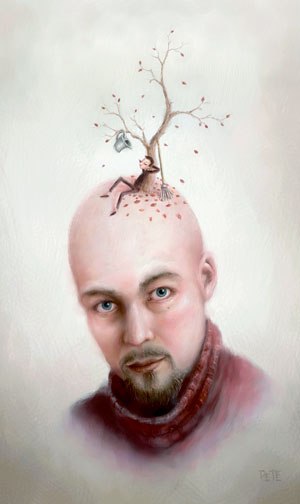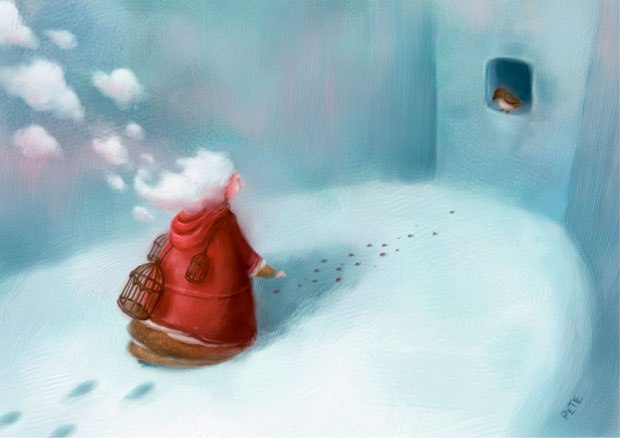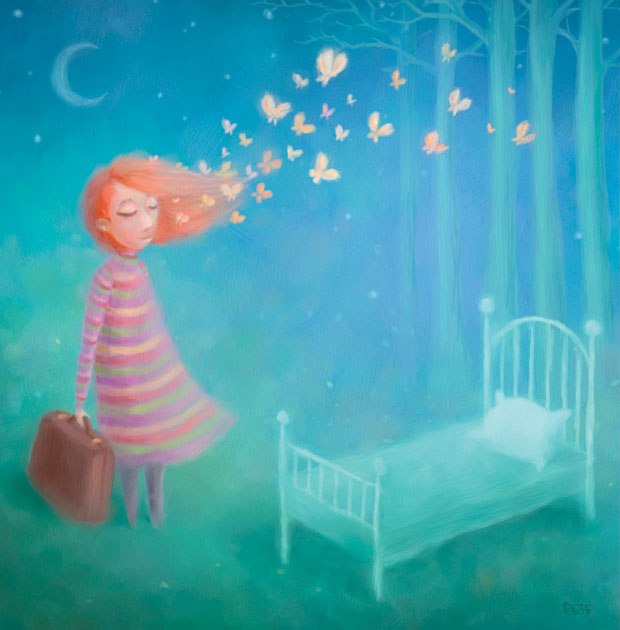In this excerpt, artist Pete Revonkorpi gives painters a lesson in smoothing.

Buy Secrets of Corel Painter Experts at Course Technology.
Pete Revonkorpi: About the Artist
I have been drawing my whole life but, professionally, I started to paint quite late — at around the age of 22.
I have always wanted to be a writer and tell stories. When I realized that the kinds of stories I wanted to tell were what people call “children's stories,” I also realized that I would need illustrations. So I decided to learn how to illustrate — to learn how to tell stories through pictures. Since then, my works have been published in numerous Finnish newspapers and magazines. I have also created other illustrated works, such as CD cover art.
In 2009, I started working with a musician to produce what we call “living and singing paintings.” They combine live digital painting with live music to tell a story without words. At this point, we have only performed here in Finland, but we hope to take our performances abroad in the future.
Studio
Software: PainterHardware: Wacom Intuos 4
Contact
Pete RevonkorpiJyväskylä, Finlandpeterevonkorpi@hotmail.comhttp://peterevonkorpi.daportfolio.com
Artist's Statement
I adore simplicity, and I try not to put anything extra in my paintings — only what is absolutely necessary. I try to strip my thoughts and emotions completely naked. Although I often use clever concepts in my paintings, they are not really what the painting is all about. It is all about the emotion the painting evokes — or doesn't evoke. For example, I can use the color blue to create a sad feeling in the painting, but I can also use a sad concept to do that. The concept of a painting is really just another one of its colors.
Influences
Anything can be inspirational. As long as you can see the invisible side of things, there is magic everywhere.
![[Figure 10.1] Smoothing over the hair and dress. [Figure 10.1] Smoothing over the hair and dress.](http://www.awn.com/sites/default/files/styles/inline/public/image/attached/48269-painter-ch10smoothing01.jpg?itok=aGbprpwR)
TechniquesStep-by-Step Tutorial: Smoothing
I don't do a lot tricks with Painter — I just paint. One thing that I do often is what I call smoothing. After I have painted something, I take the Thick Wet Oil 30 Brush and reduce its opacity to almost 0 (usually 4x6). I then pick a color that I have used a lot in the painting and just paint all over it. This smoothes the image and gives it a soft and painted look that I like a lot. I usually do this separately to different sections and objects in the painting while I work.
1. In Figure 10.1, the edges of the woman’s hair and her dress are clear to see. I use the Oils, Thick Wet Oils 30 Brush and reduce its opacity to 6. I choose a color that I have already used to paint with in the section that I want to smooth (in this case, green for the hair and orange for the dress) and paint carelessly all over it.
2. The result is a much softer image, with a much more painterly look. I use this smoothing technique in practically every one of my paintings to give them a soft and dreamlike quality.
I use Painter pretty much the same way I would paint in real life: I just pick up a brush and start painting. This is exactly why I like Painter so much — it allows my personal style to come through naturally.
InsightsThe Creative Process
I often start with little idea of what I am going to do. I might have a certain shade of color that I want to use — but anything beyond that is a mystery to me. I usually just start to slam colors and shapes together without care, and pretty soon some blob of color starts looking like something — maybe a boat. Next, I ask myself questions about the boat. Is the boat sinking? Is it just drifting, or is it going somewhere? Who are the passengers? And so on. So, actually, I don't really paint a painting; I just try to find it under all that white.
As an illustrator, the most important thing to me is that the image gives new life to the text it illustrates — that it gives a new and clear angle to the subject matter and evokes emotion or thought.
Favorite Features
In Painter, I use mostly the oil and acrylic brushes — especially the Thick Wet Oil and Wet Acrylic Brushes. I like the textures I get and the way colors blend with the oil brushes.
Timesaving Tips
Two of my biggest and simplest timesavers have been to learn the shortcut keys for the actions I use the most, and to use as many layers as possible when I paint.
These may seem like obvious things to do, but for someone like me, who usually starts painting without advance thought, they are things I have to constantly try to remember — especially when I am working on an illustration for a client. For instance, if a client wants an object to be on the right side of the image rather than on the left side, by using layers and shortcut keys, I can simply move the object to the right and show my client what it will look like. Having everything painted in different layers helps me a lot when adjusting the image later on — this way I don't have to repaint the entire image.
Finished Work
My finished work is usually displayed either printed on paper or as an image on the Internet.
Q&AWhen did you start using Painter?
I started using Painter about six years ago.
Do you integrate your work in Painter with traditional artists’ materials?
No, I do all my work in Painter — from start to finish.
How has it been for you to learn about using art tools in a digital setting?
Learning is easy in a digital environment because it is so flexible. I find it is much easier to experiment digitally than using traditional art materials.
Has Painter helped you define your own style?
Like I said, Painter has helped me experiment. The painting process is so fast and flexible, compared to traditional media, that it is much easier to try different things. Also, using Painter is much cheaper because you don't have to buy new canvases, brushes, and paints after you have wasted them on failed experiments. With Painter, you can afford to fail as many times as you want.
What motivates you?
I am motivated by the need to understand and explain. My works, or at least my personal works, are very personal. But I try to turn the personal into universal. And I am interested in the invisible side of life: things that are lost, and things that are not yet found. For example, a chair, no matter how beautifully crafted it may be, is not that interesting. But an empty chair — the fact that there is nobody sitting there — now that is interesting and inspiring! Why is it empty? Has somebody just left, or was there someone who never arrived? I don't think I could ever paint a still life of fruits in a bowl, but I would probably be ecstatic to paint just the bowl. So I guess you could say that I try to visualize the invisible.
Which artists do you admire?
My single biggest influence has been Astrid Lindgren, although she was not an illustrator, but an author. Her book Ronia the Robber's Daughter was the first book that I remember reading as a child and the first children's book I reread as an adult. When I reread it some years ago, I literally cried through all the pages — it was that powerful. I knew then that telling “children’s stories” through pictures was what I wanted to do — that illustration had to be the most powerful form, or style, of art there was. And it wasn’t just because of the nostalgia, but because the simplicity and naivety helps people to let their guard down. Most people don't expect anything other than pretty colors and whimsy from a children’s book. As a result, deep and complex emotions come as a complete surprise and are therefore more powerful.
Illustrators who I admire a lot are Tove Jansson, creator of The Moomins, and Maurice Sendak, who is, perhaps, the greatest living illustrator. I also adore the work of artists Marc Chagall and Frida Kahlo. These kinds of artists have helped me understand how much you can say with very little.
How has the Internet influenced your art-making process?
The Internet has influenced me quite a lot. Without the Internet, I would have to travel across the world to see what other people are doing, but now I can do it from my home with just a mouse click. The Internet is an endless source of inspiration.
What advice do you have for artists working with Painter?
Experiment. Take time to fiddle around with different settings. This way you will eventually find your own unique way of doing things, and your images will have your own unique look. This is what is so great about Painter[md]it allows your personal style to really come through. There is already enough clean generic digital art out there!
Links
* http://peterevonkorpi.daportfolio.com
* http://www.youtube/user/PeteRevonkorpi
Daryl Wise has worked for the past 15 years as the owner/operator of StreetWise PR, a small public relations and marketing firm near the Silicon Valley. Some clients include or have included Macworld Expos, the artist Peter Max, HP, Ambient Design, Adesso, Pixelmator, GLUON, and e frontier. He was director of the Santa Cruz Digital Arts Festival for three years and is a member of Cabrillo College's Digital Arts Advisory Committee. He is the author of Secrets of Award-Winning Digital Artists, Secrets of Poser Experts, and Secrets of Painter Experts.
Linda Hellfritsch holds degrees in traditional art and graphic design. She is a fine artist, freelance commercial artist, Web designer and writer living in La Selva Beach, California. She has curated and hung both traditional and digital art exhibitions in San Jose, San Francisco, Monterey, San Clemente and Santa Cruz. Her areas of expertise include art, design, art history, and arts education. Linda works primarily with traditional mixed media although her work has required her to design and develop digital graphic arts products. This exposure to digitally produced art has awakened a curiosity and hunger to learn more about digital art tools. She has spent the past several years talking to digital artists, experiencing their work and learning their secrets. Linda's background in traditional fine art gives her a unique perspective as a traditional artist in a digital world. In her spare time, she works as a scenic painter and props builder at the new Crocker Theater in Aptos, California.















